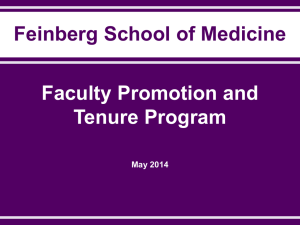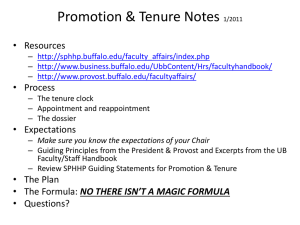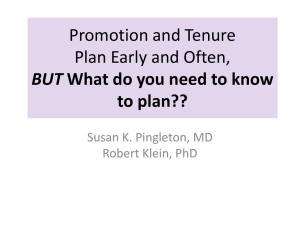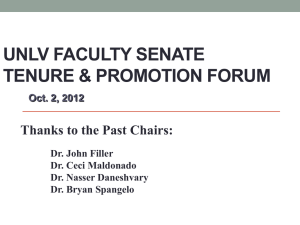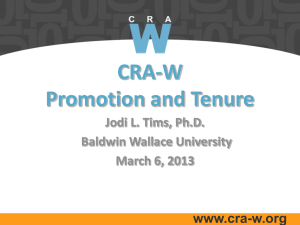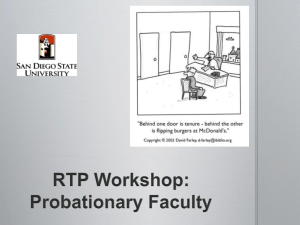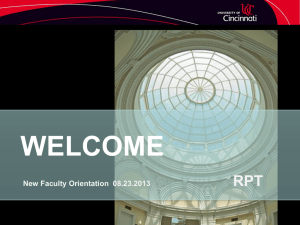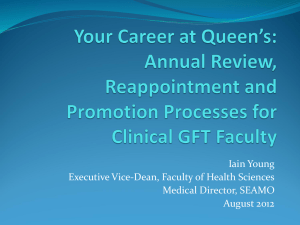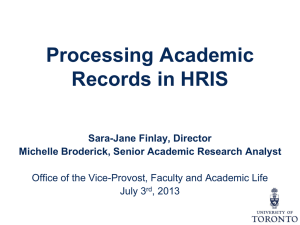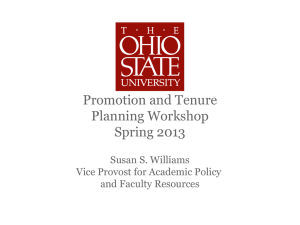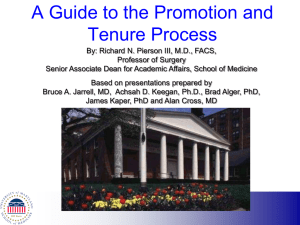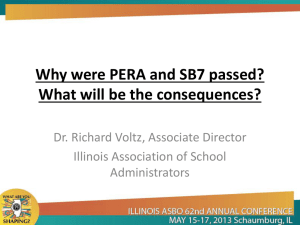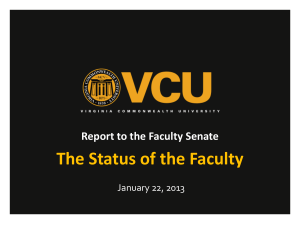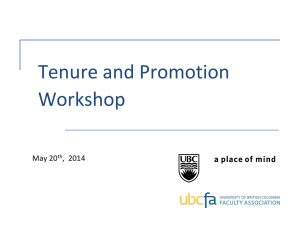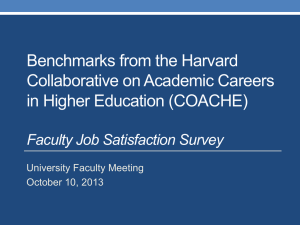Laurel Weldon presentation
advertisement
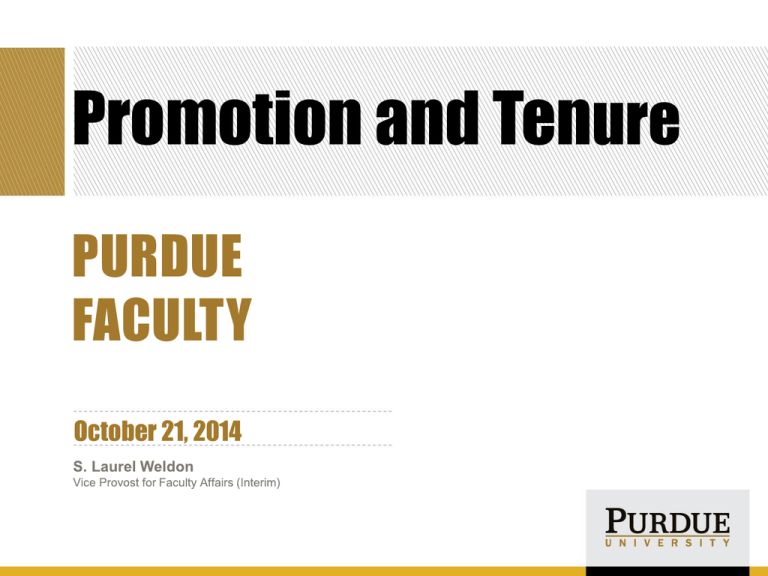
Promotion and Tenure PURDUE FACULTY October 21, 2014 Purdue faculty by rank Tenure Track Faculty Clinical Faculty Total 1,807 121 Assistant 352 71 Associate 556 36 Full 755 14 Deans and DHs 144 Purdue Tenure-Track Faculty by Rank 2012-13 Assistant Professors 19% Full Professors 50% Associate Professors 31% Tenured, Tenure Track Faculty by Gender, URM by Rank Fall 2013 83% 81% 66% 64% 53% 47% 36% 34% 19% 17% 9% Assistant 10% 9% Associate 4% Professor % Female 1% Heads, Asst. & Academic Assoc. Deans, Asst. & Assoc. Deans % Male % URM Promotion and Tenure • One of the strongest predictors of pre-tenure faculty satisfaction and success is understanding the promotion and tenure process. • • At Purdue, the process is described in Executive Memorandum B-48, Section II and in Provost’s Letter • http://www.purdue.edu/provost/faculty/promotion.ht ml • An updated Promotion and Tenure Policy is under development. 5 Tenure at Purdue …to be considered for promotion, a faculty member should have demonstrated excellence and scholarly productivity in at least one of these areas. Ordinarily, strength should be manifest in more than one of these areas.” Scholarship of “ Learning (teaching) Engagement (dept., profession, university, community, state, world) Discovery (research) 6 Tenure at Purdue • To receive tenure, “a successful candidate should have a significant record of accomplishment as a faculty member and show promise of continued professional growth and recognition.” • Candidates are considered on “standards appropriate for the nominee’s discipline and the University’s criteria for promotion.” 7 CLINICAL FACULTY Clinical Faculty have a distinct path to promotion (but not tenure). They are considered by a different panel (Panel X or now “B”) rather than the usual Panel A. This review panel incorporates more clinical faculty. Tenure at Purdue: 2013-2014 • 107 faculty were reviewed for promotion by the University Promotions Committee and 107 were approved for promotion (100%) • 51/51 (100%) were successfully promoted to full professor • • 56/56 (100%) were successfully promoted to associate professor • In addition, 5 clinical faculty were promoted (3 to associate clinical and 2 to full clinical professors) - 100% • 11 Nominations did not go to UPC (Flashpoint equally divided between area and primary committee) 9 2013 Faculty Promotion and Tenure by Major Area of Focus (# of people) One basis Discovery Engagement Learning Full Professor 28 29 13 14 Associate Professor 48 39 21 75 Two or more bases Discovery and Engagement Discovery and Learning Learning and Engagement All Three Full Professor 11 11 10 00 Associate Professor 23 33 41 01 University Promotion and Tenure Rates* Females Promoted # % Males Promoted # % Minorities Promoted # % Total Promoted # % 2003-04 22 79% 53 75% 20 100% 75 76% 2004-05 23 77% 57 78% 17 85% 80 78% 2005-06 23 100% 55 92% 22 96% 78 94% 2006-07 31 89% 65 88% 26 90% 96 88% 2007-08 32 91% 57 83% 30 94% 89 86% 2008-09 24 92% 70 89% 33 89% 94 90% 2009-10 32 87% 69 85% 31 84% 101 86% 2010-11 32 100% 76 92% 43 96% 108 94% 2011-12 27 82% 59 87% 24 80% 86 85% 2012-13 34 94% 64 100% 34 94% 98 98% * 2011-12 was the first year to reflect all faculty considered for promotion and tenure. Time to Tenure Assistant Professors typically have a probationary period up to 6 years to earn promotion and tenure. The 6th year is called the “penultimate year.” It is the last year in which one is eligible for tenure. Entering associate professors have 3 years to work toward tenure. The 3rd year is penultimate year. 12 Tenure Clock Extensions: When conditions and personal circumstances substantially interfere with progress toward achieving tenure A one-year automatic approval will be granted for birth of a child and adoption, provided a Request for TenureClock Extension form is submitted within one year of the occurrence and prior to the penultimate year. This provision applies to either or both parents. Justifiable conditions for granting exclusions include, but are not necessarily restricted to, severe illness, disability, or care-giving of a family member. 13 Some Things to Ask About • Guidelines for P and T: What are the criteria? Written guidelines? • Promotion evaluation may be different from the annual merit salary review. • When will you be evaluated and by whom? (Frequency and people) • Is there a formal third year evaluation? external input? • Specific criteria for quality and impact of research and teaching: • e.g. Journal listing (sometimes specified for promotion process) • Guidelines for evaluation of teaching • Format for promotion and/or tenure document – get past examples • Develop a plan for moving toward promotion and/or tenure • How will you publish enough articles? • How will you document teaching success? • Ask for a Mentor and demand regular, written feedback early Keys to faculty success and well-being Starting Early, Planning and Gathering Information Getting oriented to the institution Learning what is expected early on Learning the tenure and promotion process Begin and plan with the end in mind Start with research and teaching- don’t lose focus! Seek excellence (as defined by your discipline) Engagement and service increase over one’s career Creating work-life balance Find a sustainable rhythm Be aware of supports Ask for what you need: stop the clock, parental leave Form 36 The President’s Office Nomination for Promotion Form (Form 36): Available On-Line http://www.purdue.edu/provost/faculty/promotion.html More useful: Instructions for filling out the form 36 http://www.purdue.edu/provost/documents/Form36INSTR%202014-15AY.pdf More useful still: The template your college or department uses. Get an electronic example of a successful form 36 and start filling it in Keys to faculty success and well-being cntd)( Seek help and support actively and widely Developing professional networks/mentors inside AND outside the department Letter writers are outside the department Soliciting feedback from senior faculty and head They will be on primary committee Pay attention to annual reviews Get concrete and specific advice about journals, etc Seek advice from multiple mentors/sources Get multiple examples of success- e.g. Form 36 Know your rights and obligations
